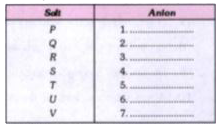Statement-1: Zinc hydroxide dissolves in excess of NaOH solution to evolve dihydrogen gas.
Statement-2: Zinc hydroxide is amphoteric in nature.
Statement-1 is true, statement-2 is true, statement-2 is a correct explanation for statement-1
Statement-1 is true, statement-2 is true, statement-2 is not correct explanation for statement-1
Statement-1 is true, statement-2 is false
Statement-1 is false, statement-2 is true
The correct Answer is:D
To analyze the statements regarding zinc hydroxide, let's break down the information step by step.
Step 1: Understanding Statement 1
Statement 1: Zinc hydroxide dissolves in excess of NaOH solution to evolve dihydrogen gas.
- Zinc hydroxide (Zn(OH)₂) is known to be amphoteric, which means it can react with both acids and bases.
- When zinc hydroxide is treated with excess sodium hydroxide (NaOH), it does not evolve dihydrogen gas. Instead, it forms a soluble complex, sodium zincate (Na₂ZnO₂), and water.
Conclusion for Statement 1: This statement is false because zinc hydroxide does not evolve dihydrogen gas when it dissolves in NaOH.
Step 2: Understanding Statement 2
Statement 2: Zinc hydroxide is amphoteric in nature.
- As mentioned earlier, zinc hydroxide can react with both acids and bases.
- When it reacts with acids, it behaves as a base, forming zinc ions (Zn²⁺) and water.
- When it reacts with bases, it behaves as an acid, forming complex ions like Zn(OH)₄²⁻ or Na₂ZnO₂.
Conclusion for Statement 2: This statement is true because zinc hydroxide exhibits amphoteric behavior.
Final Conclusion
- Statement 1: False
- Statement 2: True
Thus, the correct answer is that Statement 1 is false and Statement 2 is true.
---
Statement 1: Zinc hydroxide dissolves in excess of NaOH solution to evolve dihydrogen gas.
- When zinc hydroxide is treated with excess sodium hydroxide (NaOH), it does not evolve dihydrogen gas. Instead, it forms a soluble complex, sodium zincate (Na₂ZnO₂), and water.
Statement 2: Zinc hydroxide is amphoteric in nature.
- When it reacts with acids, it behaves as a base, forming zinc ions (Zn²⁺) and water.
- When it reacts with bases, it behaves as an acid, forming complex ions like Zn(OH)₄²⁻ or Na₂ZnO₂.
- Statement 1: False
- Statement 2: True
Topper's Solved these Questions
- HYDROGENBOOK - AAKASH INSTITUTE ENGLISHCHAPTER - HYDROGENEXERCISE - Assignment (Section-F)
3 Videos
- HYDROGENBOOK - AAKASH INSTITUTE ENGLISHCHAPTER - HYDROGENEXERCISE - Assignment (Section-G)
2 Videos
- HYDROGENBOOK - AAKASH INSTITUTE ENGLISHCHAPTER - HYDROGENEXERCISE - Assignment (Section-D)
5 Videos
- HYDROCARBONSBOOK - AAKASH INSTITUTE ENGLISHCHAPTER - HYDROCARBONSEXERCISE - Assignment(Section - C) (Previous Years Questions)
60 Videos
- M0ck test 26BOOK - AAKASH INSTITUTE ENGLISHCHAPTER - M0ck test 26EXERCISE - EXAMPLE
43 Videos
Similar Questions
Zinc dissolves in concentrated NaOH solution to produce dihydrogen as well as dioxygen gas.
View SolutionA : Zn dissolve in excess of NaOH solution so as to give H2
R : Zn(OH)2 is neutral is nature.
View SolutionExcess of sodium hydroxide is added to zinc hydroxide.
View SolutionTin dissolves in excess of sodium hydroxide solution to form _____________ .
View SolutionThe hydroxide of which metal ion(s) which is/are soluble in excess of NaOH solution
View SolutionSalts P, Q,R,S,T,U and V undergo reactions (i) to (vii) respectively. Identify the cation present in these salts on the basis of these reactions. Tabulate your answer in the formate given below.
(i) When the salt Pis heated with sodium hydroxide solution a vigorous reaction takes place and a colourless gas is evolved with a pungent and suffocating smell that brings tears in our eyes. The evolved gas gives dense white fumes with a moist glass rod depped with hydrochloric acid.
(ii) Addition of sodium hydroxide solution to a solution of salt Q gives a thick white precipitae which is soluble in excess of sodium hydroxide solution to form a clear solution.
(iii) Addition of ammonium hydroxide solution to a solution of salt R gives a dark blue precipitate which is soluble is excess of ammonium hydroxide solution to form an intense deep blue solution.
(iv) Addition of ammonium hydroxide solution to a solution of 5 gives a dirty green [bottle green] precipitate which is insoluble even in the excess of ammonium hydroxide solution.
(v) Addition of ammonium hydroxide solution to a solution of T gives a reddish brown (rust precipitate] precipitate which is insoluble even in the excess of ammonium hydroxide solution.
(vi) Addition of ammonium hydroxide solution to a solution of V gives a geletaneous white precipitate which is soluble in excess of ammonium hydroxide solution to form a clear solution.
(vii) Addition of ammonium hydroxide solution to a solution of V gives no precipitate but it gives a chalky white precipitate with sodium hydroxide solution which is insoluble even in the excess of sodium hydroxide solution.

View SolutionStatement-1: Hydroxides of group-2 are less soluble in water than hydroxides of group-1.
Statement-2: CaF2 is least soluble in among other fluoride of group-2.
Statement-3: Li gives red coloured flame.
View SolutionComment over the following statement
Ga2O3 is an amphoteric oxide.
View SolutionStatement-1:White precipitate of zinc phosphate is soluble in Ammonia.
Statement-2:Zinc phosphate forms a soluble complex with ammonia.
View SolutionStatement-1 :White precipitate of Mg(OH)2 is insoluble in excess of sodium hydroxide but readily soluble in solution of ammonium salts.
Statement-2 :Mg(OH)2 is very sparingly soluble in water.
View Solution
